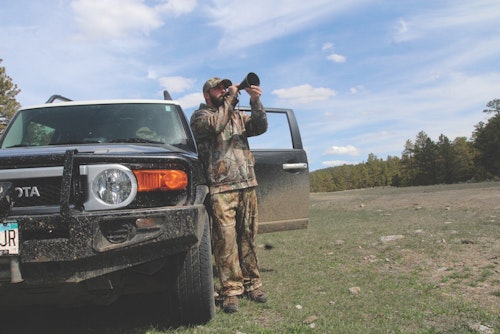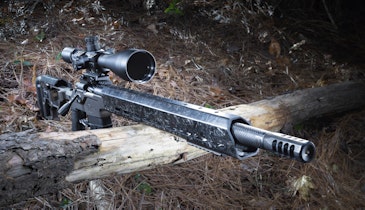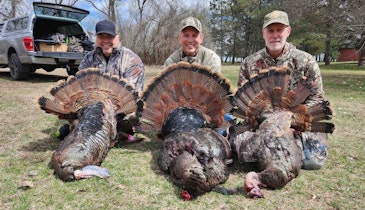Have a look in any fisherman’s tackle box, and there’s sure to be a wide variety of lures of all shapes, sizes and colors. Experience has taught anglers that they must be prepared to tackle various light and water conditions, as well as multiple fish species and sizes. And they need to be equipped to mimic the most prevalent natural food sources — and to roll with the whims of those pea-size fish brains. They often sift through a large assortment of different size and color lures before landing on that perfect combination that provokes a feeding frenzy on that particular occasion. An hour later, all bets might be off, and a completely different setup might work better.
Turkey hunters, too. They might run through several diaphragm, box and slate calls during the course of the morning before finding the one that gets a hung-up tom to fire up and come their way.
Same goes for calling predators — those crafty canines and fearless felines. Different situations require different applications. Some choices can be made before striking out — such as whether it makes more sense to use an e-caller instead of mouth calls, selecting social vocalizations over food-based sounds or choosing calls that are more appropriate for the target species. Refinement of those choices can be made on the fly as conditions dictate.
Let’s start with e-callers. There are a number of reasons for choosing e-callers over mouth calls. A lot of it has to do with the proficiency of the caller — e-callers transform newbies into proficient callers — and are a good choice for those who don’t have the experience or confidence to use mouth calls. By using an e-caller and the smorgasbord of animal sounds they produce, the learning curve is shortened considerably.
But there are at least three other reasons aside from ease of use I can think of for using e-callers instead of mouth calls.
Sustained Volume — I give a high-quality e-caller the nod when hunting in windy conditions because of the substantial volume they produce. Predators won’t come if they can’t hear the calls, and e-callers outshine mouth calls when it gets blustery. And in some cases it’s prudent to call continuously throughout the setup — not an easy task with a mouth-blown call. This is especially true when hunting bobcats, lions and black bears. These critters are much slower to response to the call and seem to lose interest between calling intervals.
Variety and Versatility — Remember the fisherman’s tackle box? E-callers put a wide array of food source and social sounds at the hunter’s fingertips. They don’t have to rely on the more limited sounds produced by mouth calls. This is important where hunters routinely return to the same property to call — or when hunting public grounds, where every predator hunter and his brother rely on mouth-blown rabbit-in-distress calls. Go back to the well with the same sounds too many times and production will diminish, as resident predators recognize the association between those calls and human presence. E-callers provide the opportunity to mix it up.

Remote Control — When alone, a hunter can be his own best hunting buddy by using an e-caller and positioning himself downwind of the speaker and operating it remotely. This way he can intercept predators circling downwind. Obviously this tactic takes two hunters when using mouth calls.
And here’s a bonus. An e-caller is great teaching tool. New hunters can learn to mimic the recorded sounds with their mouth calls until they’ve acquired the confidence to use them in the field.
With all of that in mind, why would anyone ever use a mouth call instead of an e-caller? Again, there are good reasons to choose one or the other — and that holds true for choosing mouth calls over e-callers in some situations.
First off, even with all of their attributes, e-callers have their downfalls. First and foremost, they are electrical/mechanical devices, and there’s always the chance they might break down at the most inopportune time — or the batteries might go dead (a real problem in cold climates). Second, they are somewhat bulky — not always the best choice for run-and-gun hunters who plan to leave the truck far behind and venture off on foot all day. Sometimes traveling light trumps any advantages e-callers might offer.
While I use e-callers for the aforementioned reasons, I’m a big fan of mouth calls. Like many seasoned callers, I get satisfaction from fooling predators with the homemade sounds I craft from them, and I also like the simplicity of just grabbing two or three calls, my favorite fur gun and a butt pad and hitting the hunting grounds running. And going back to the fisherman analogy, there are probably as many different mouth calls available as there are lures in that angler’s tackle box. So which calls are appropriate for the various situations predator hunters face in the field?
First off, mouth-blown calls fall into four general categories: diaphragm, open-reed, closed-reed and howler. And in each of these categories, calls can produce a variety of unique sounds based on their size and design, and the materials from which they’re made. Determining which calls are best suited for a particular situation is often based on several criteria: weather, terrain, species being called and time of year.
Diaphragm Calls:
Good news … These are a good choice for run-and-gun hunters who want to minimalize the amount of gear they carry in the field. They are very versatile and can produce a wide variety of sounds, such as rabbits, rodents and birds in distress, as well as coyote howls, barks and pup whines. Hands-free application is a plus when it’s time to do the dirty deed. And, finally, these calls are reasonably priced.
Bad news … One downside is that they’re tough to master and require considerable practice. A good buddy once told me that you aren’t an expert with a diaphragm call until you’ve swallowed one of every color. Another negative is that they don’t produce a lot of volume, so they are not as effective on windy days or in heavy cover where sound doesn’t carry as well.
Best applications … They work great as a “coaxer” call once a responding critter is spotted and perhaps hung up. The hunter can keep both hands on the gun and minimalize movement while operating the call. They are a good choice for calling foxes or bobcats because of the soft, low volume bird and rodent sounds they produce. On the social side they also produce decent coyote howls, barks and pup whines.

Closed-Reed Calls:
Good news … Of the mouth-blown calls, these are by far the easiest to operate, and even those new to the game can become proficient with them in short order. By regulating the amount of air blown through the enclosed reed, and cupping a hand over the end of the tube, the hunter is able to produce various pitches and volume. Closed-reed calls produce decent volume and come in a variety of sizes to create a variety of prey-in-distress sounds.
Bad news … These calls are limited to producing prey-in-distress sounds, which means those hunters who use them exclusively must rely solely on food-source sounds. And when hunting heavily pressured areas, this lack of variety — and the absence of a social game (howls, barks and whines) — might be a detriment, as predators become call shy from hearing the same sounds over and over. Also, these calls have a tendency to freeze up in cold conditions, often requiring the hunter to dismantle them.
Best applications … Great for the run-and-gun hunter who wants to travel light. He can carry several of these calls — of various sizes — to produce a variety of sounds and volume until he finds one that works best in a particular situation. For example, use smaller, closed-reed calls to produce rodent and birds sounds when targeting foxes and bobcats, and larger calls that produce rabbit-in-distress sounds for coyotes. Larger calls are a better choice when calling in windy conditions because they produce more volume than smaller calls.
Open-Reed Calls:
Good news … Those who become proficient with open-reed calls are able to produce a wide variety of food-source sounds, as well as coyote vocalizations. Volume is easy to control and by moving the exposed reed forward or backward between the lips, the caller can alter the pitch. They also perform better than closed-reed calls in cold weather because the caller can keep the exposed reed in his mouth to keep it from freezing.
Bad news … Probably the biggest disadvantage of the open-reed call is that they’re more difficult to operate — which, of course, can be overcome with practice. Unlike the closed-reed call, where the reed is protected inside the body of the call, the open-reed call’s exposed plastic reed can be damaged from the elements or careless use or storage. Because of its exposed nature, the reed will lose tonal quality with age and should be replaced from time to time.
Best applications … Again, many of the same attributes as closed-reed calls, in that they are very portable, come in many sizes and are affordable — great for hunters on the go who don’t want to be weighed down by an e-caller. Because these calls produce both food-source and social sounds, they are very versatile and are especially effective for calling coyotes during the mating and pup rearing seasons. If food-source sounds are not working, the hunter can quickly switch to coyote vocalizations to exploit the territorial nature of coyotes this time of year. Small, open-reed calls are also very effective for mimicking those subtle bird and rodent sounds that foxes and bobcats can’t resist.

Howlers:
Good news … Howlers can produce very convincing coyote vocalizations, such as howls, barks and whines — great for locating coyotes or challenging their territorial dominance. Using howlers in tandem with food-source calls means the hunter isn’t reliant on prey-in-distress sounds and can appeal to the social nature and curiosity of these highly gregarious animals when food source sounds aren’t working.
Bad news … They might scare off any submissive and young coyotes, as well as any foxes or bobcats where a mixed bag of predators is possible. Limited to making coyote vocalizations, so it’s important to carry a variety of other calls, too.
Best applications … By driving the back roads at night or during the wee morning hours — stopping periodically to howl — it’s possible to locate responding coyotes and determine those most productive places to set up at first light. The howler is a great calling tool during breeding and denning seasons, when coyotes defend their territories from intruders, and they also appeal to the gregarious nature of coyotes — and they will often come over to see who’s new in the neighborhood.
Variety is the spice of life, so they say. And this adage certainly holds true for predator hunting. Just as a fisherman knows that a single lure won’t get the job done every time in every situation, and a turkey hunter knows it might take the perfect call that makes just the right sound to get a hung-up tom turkey to respond, predator hunters might need to dig deep into their bag of tricks and treats to turn the table on those crafty canines or finicky felines. And having a vast arsenal of various calls and sounds for every occasion — and knowing which ones to use and when — will help savvy predator hunters do just that.






